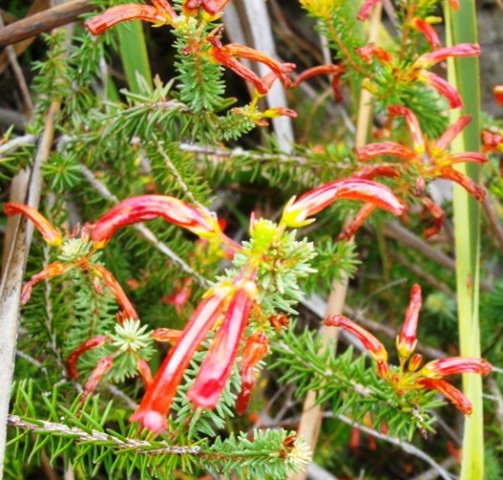Erica

Author: Ivan Lätti
Photographer: Ivan Lätti
Ericas are among the plants with the oldest recorded botanical or pre-botanical descriptions. Theophrastus, student of Aristotle who wrote about plants in the 4th century BC was the first whose reference to Ereike plants was preserved until our time. There is a story that the meaning of the Greek word ereike, "to break" was attached to the plants in the context of its early medicinal use. The belief was that infusions prepared from certain ericas served to break up gall stones or kidney stones. (Details on such matters are understandably a little vague.)
Fortunately medicine has advanced much since those days. And the ancient Greeks never knew more than a fraction of the Erica species on earth, most of them for long a secret of the San and Khoi tribes of the Cape.
Pliny, the Elder, the Roman equestrian soldier and encyclopaedist who lived in Pompeii at the time of the 79 AD earthquake (that destroyed his city and killed him), had also noted plants by this name.
The plant descriptions preserved from classic times show the range of early human interest in plants. It is not only food plants or trees yielding wood for weaponry and shelter that were noted and recorded. Curiosity and the beginnings of learning took the ancient scribes even beyond plants with medicinal uses. Aromatic plants and beautiful flowering species were also named, recorded and grown. From even before this time records exist of Xerxes, Emperor of Persia, studying and collecting of plants during his campaign against the Greeks in 480 BC, for his gardens back home.
Recorded human history is not much older than five to six thousand years. But human curiosity and observation of all kinds of details, social systems providing for learning and languages existed long before the invention of writing and recording. This enabled the human race from many thousands of years ago to notice and appreciate nature. Could it have started 50 000 years ago? Or double that?
Other species, particularly among the mammals, have shown aesthetic sense of some sort, at least in music. How far has this come and is it still developing? How wide is the range of species with eyes that will stare at an Erica flower for no other reason than its beauty? What is the evolutionary sense of such capacity in sentient beings?
The ancient records relating to Erica plants from around the Mediterranean Sea is a link to the about 14 Erica species that Europe still has in our time. Africa from Ethiopia to Zimbabwe has some Erica species in restricted habitats mainly along the Rift Valley and the mountains near the big lakes. The bulk of the diversification or differentiation of the genus Erica occurred in Southern Africa where so many species of this fynbos-centred genus grow.
The rich heritage of locally endemic plants contains the ericas as its biggest genus. They flower on mountains and valleys, around the farms and towns for all to enjoy. Getting to know them is a start towards participating in conserving them (Marais, (Ed.), 2017; Manning, 2007; Baker and Oliver, 1967; Wikipedia).

